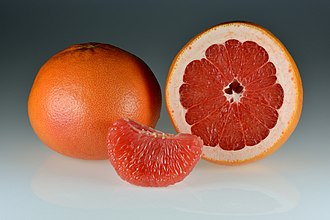Grapefruit: Difference between revisions
CSV import |
CSV import |
||
| Line 53: | Line 53: | ||
[[Category:Tropical fruit]] | [[Category:Tropical fruit]] | ||
[[Category:Medicinal plants]] | [[Category:Medicinal plants]] | ||
<gallery> | |||
File:Grapefruits - whole-halved-segments.jpg|Grapefruit | |||
</gallery> | |||
Latest revision as of 01:23, 20 February 2025

Citrus fruit
The grapefruit (Citrus × paradisi) is a subtropical citrus tree known for its relatively large, sour to semi-sweet, somewhat bitter fruit. The interior flesh is segmented and varies in color from white to yellow to pink to red. The grapefruit is a hybrid originating in Barbados as an accidental cross between two introduced species, the sweet orange (Citrus sinensis) and the pomelo (Citrus maxima), both of which were introduced from Asia in the 17th century.
History[edit]
The grapefruit was first documented in 1750 by the Welshman Reverend Griffith Hughes describing specimens from Barbados. It was originally called the "forbidden fruit" of Barbados. The grapefruit's name alludes to clusters of the fruit on the tree, which often appear similar to grapes.
Description[edit]
Grapefruit trees usually grow to around 5–6 meters tall, although they can reach 13–15 meters. The leaves are dark green, long (up to 15 cm), and thin. The flowers are white, with four petals and a diameter of 5 cm. The fruit is yellow-orange skinned and generally an oblate spheroid in shape; it ranges in diameter from 10–15 cm. The flesh is segmented and acidic, varying in color depending on the cultivars, which include white, pink, and red pulps of varying sweetness.
Cultivation[edit]
Grapefruit is grown in subtropical regions worldwide. Major producers include the United States, particularly Florida, Texas, and California, as well as China, South Africa, and Mexico. The fruit thrives in well-drained sandy soils and requires a warm climate with plenty of sunlight.
Nutritional Value[edit]
Grapefruit is a rich source of vitamin C, providing 52% of the daily value in a 100-gram serving. It also contains smaller amounts of vitamin A, calcium, and iron. The fruit is low in calories, with about 32 calories per 100 grams, and is composed of 90% water.
Health Benefits[edit]
Grapefruit is known for its health benefits, including boosting the immune system, aiding in weight loss, and improving heart health. It contains antioxidants such as flavonoids, lycopene, and beta-carotene, which help reduce inflammation and protect against chronic diseases.
Drug Interactions[edit]
Grapefruit and grapefruit juice can interact with several medications, leading to potentially serious side effects. This is due to compounds in grapefruit that inhibit the cytochrome P450 enzyme CYP3A4, which is involved in the metabolism of many drugs. Patients taking medications should consult their healthcare provider before consuming grapefruit products.
Related Pages[edit]
References[edit]
<references group="" responsive="1"></references>
-
Grapefruit

